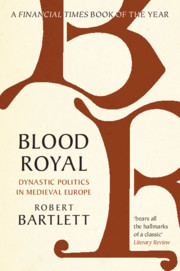Book contents
- Blood Royal
- The James Lydon Lectures in Medieval History and Culture
- Blood Royal
- Copyright page
- Dedication
- Contents
- Figures
- Preface and Acknowledgements
- Abbreviations
- Introduction Royal Families
- Part I The Life Cycle
- Chapter 1 Choosing a Bride
- Chapter 2 Waiting for Sons to be Born
- Chapter 3 Fathers and Sons
- Chapter 4 Female Sovereigns
- Chapter 5 Mistresses and Bastards
- Chapter 6 Family Dynamics
- Chapter 7 Royal Mortality
- Part II A Sense of Dynasty
- Book part
- Notes
- Bibliography of Works Cited
- Index
Chapter 2 - Waiting for Sons to be Born
from Part I - The Life Cycle
Published online by Cambridge University Press: 09 July 2020
- Blood Royal
- The James Lydon Lectures in Medieval History and Culture
- Blood Royal
- Copyright page
- Dedication
- Contents
- Figures
- Preface and Acknowledgements
- Abbreviations
- Introduction Royal Families
- Part I The Life Cycle
- Chapter 1 Choosing a Bride
- Chapter 2 Waiting for Sons to be Born
- Chapter 3 Fathers and Sons
- Chapter 4 Female Sovereigns
- Chapter 5 Mistresses and Bastards
- Chapter 6 Family Dynamics
- Chapter 7 Royal Mortality
- Part II A Sense of Dynasty
- Book part
- Notes
- Bibliography of Works Cited
- Index
Summary
The search for a bride, with all its complexities, its political implications and its possible cultural consequences, had a simple goal: the birth of a child. This was the biological event on which the fortunes of kingdoms turned. Rulers in the patriarchal and dynastic world of medieval Europe were expected to be brave, violent, aggressive, forceful – qualities that were associated with men. But the thing on which dynastic continuity, and indeed the very existence of dynasties, relied, was the female body, and what it alone could do: conceive and give birth. So, once the new bride had been chosen, attention focussed on her ability to conceive children, especially sons. The natural fertility and mortality of upper-class and lower-class people were probably quite similar, but age at marriage might be different. In late medieval England, it has been calculated, women of the top level of the aristocracy married, on average, at seventeen, men at twenty-two. It seems, however, that practices at the very apex of the social hierarchy, the rulers, often included much earlier marriage.
- Type
- Chapter
- Information
- Blood RoyalDynastic Politics in Medieval Europe, pp. 52 - 88Publisher: Cambridge University PressPrint publication year: 2020

